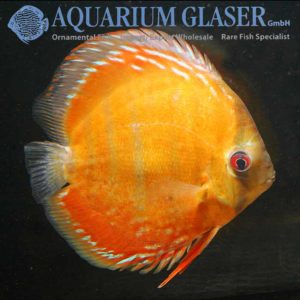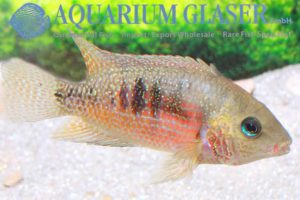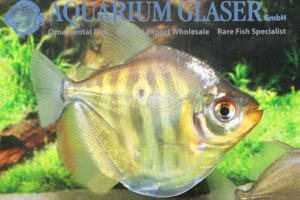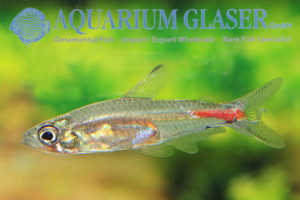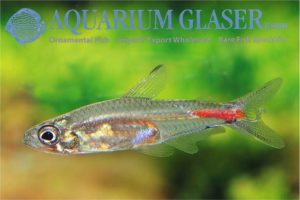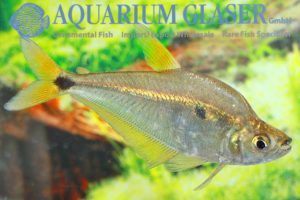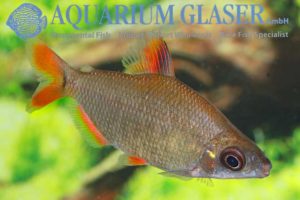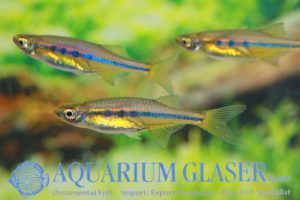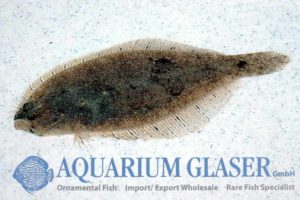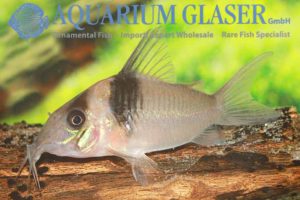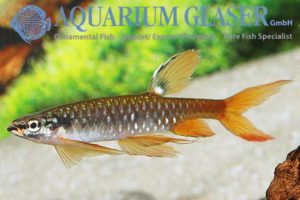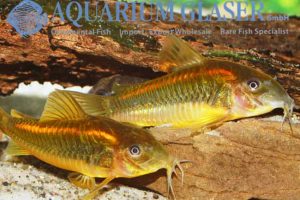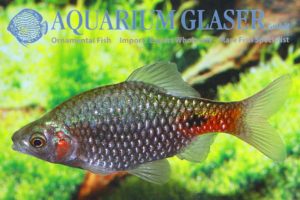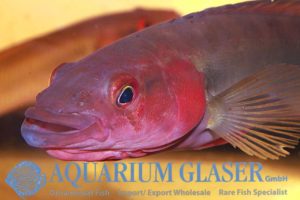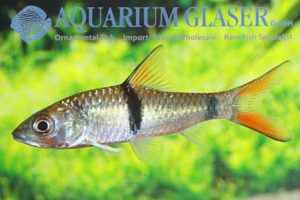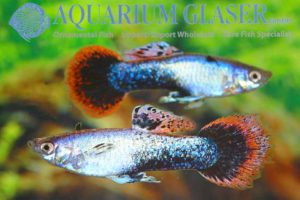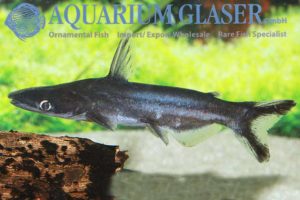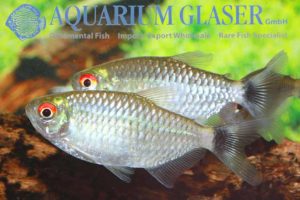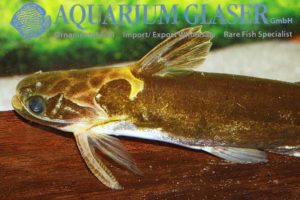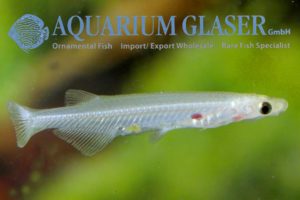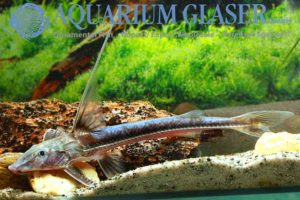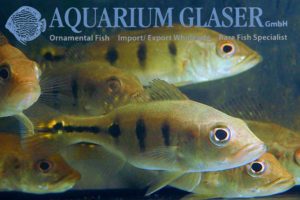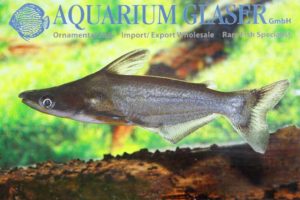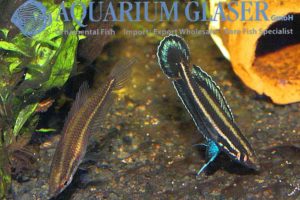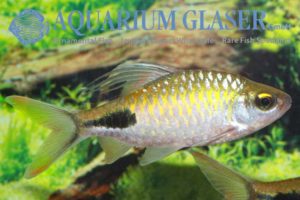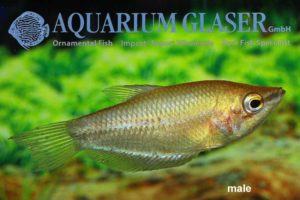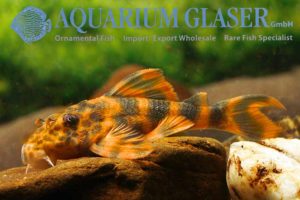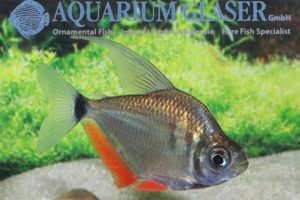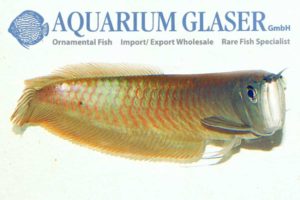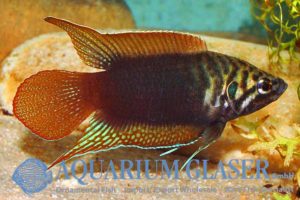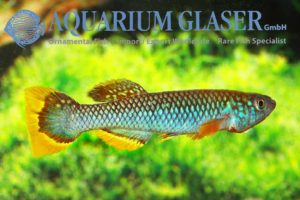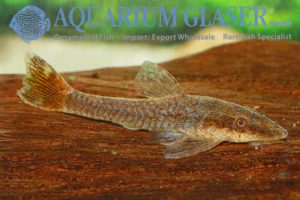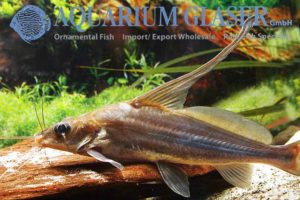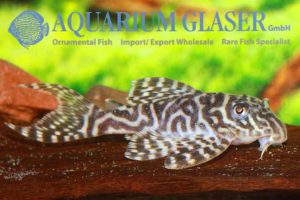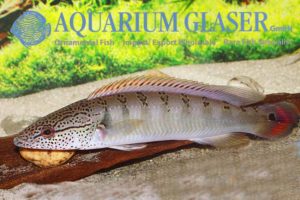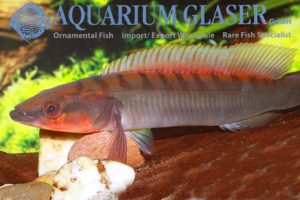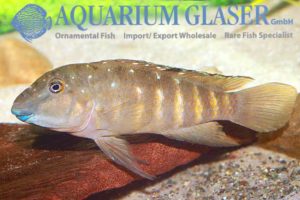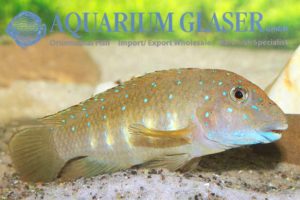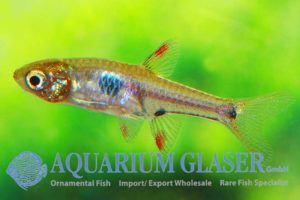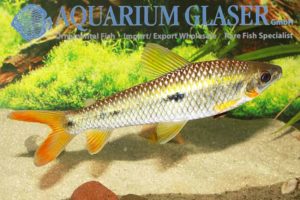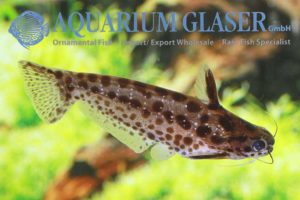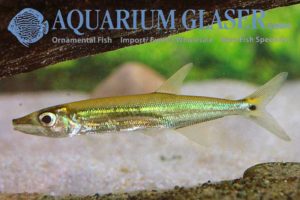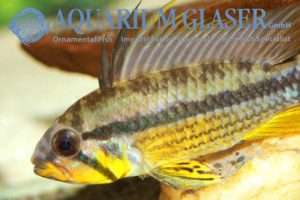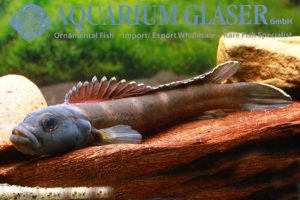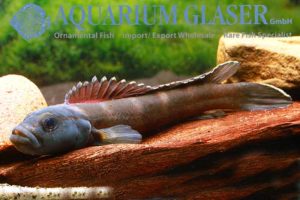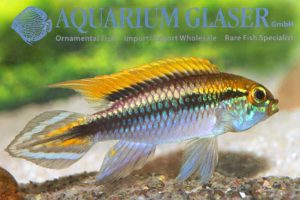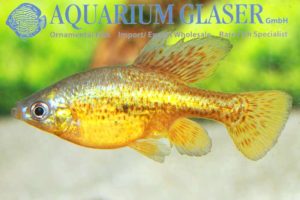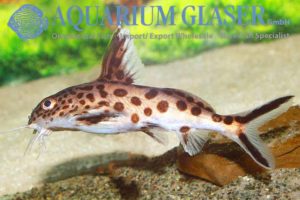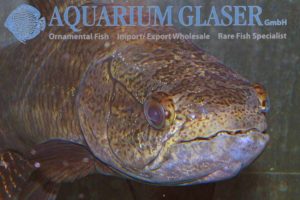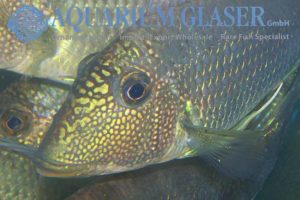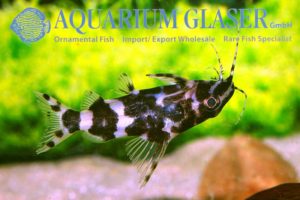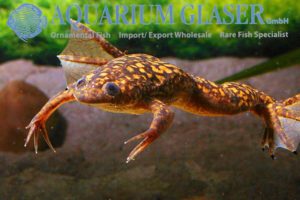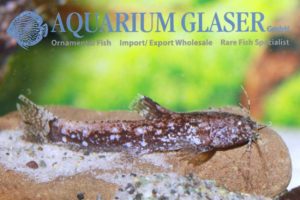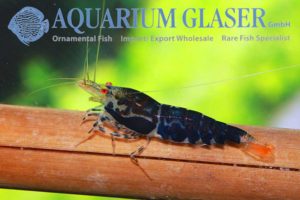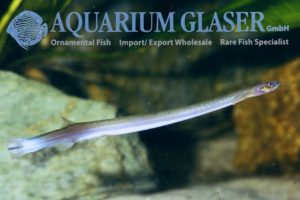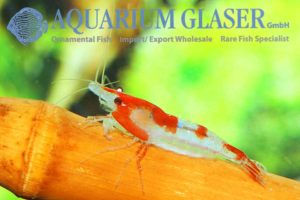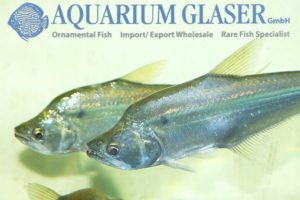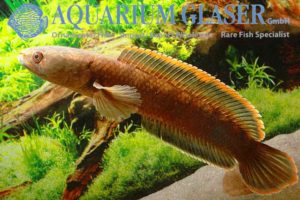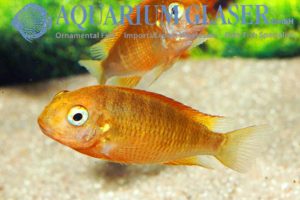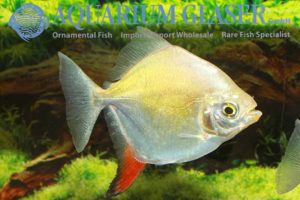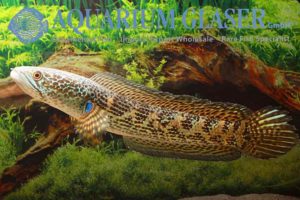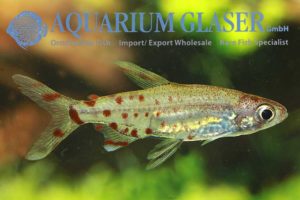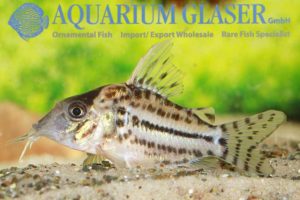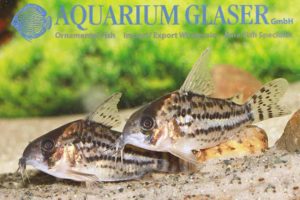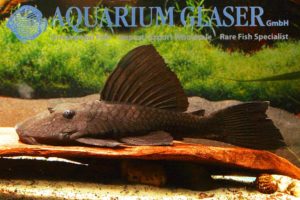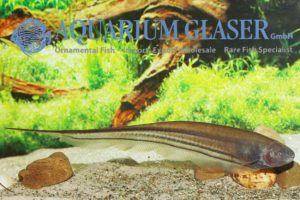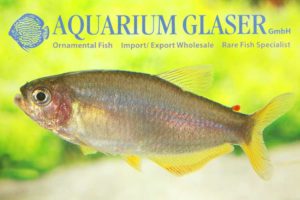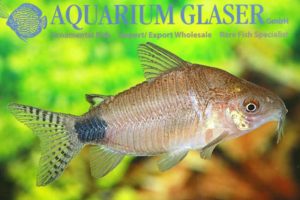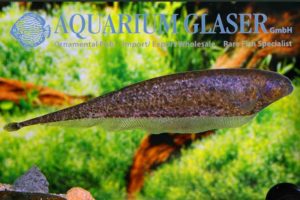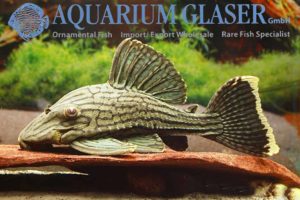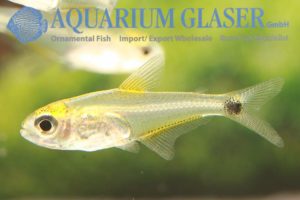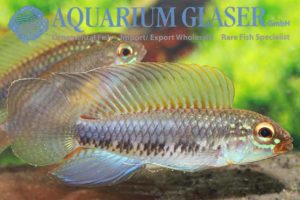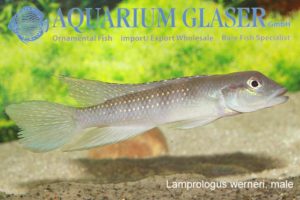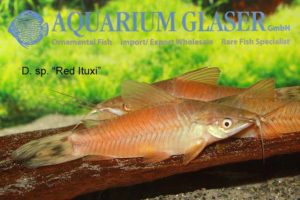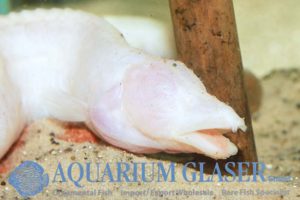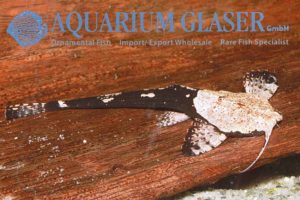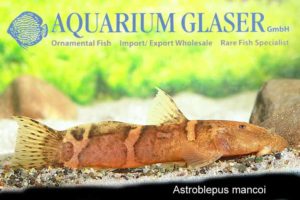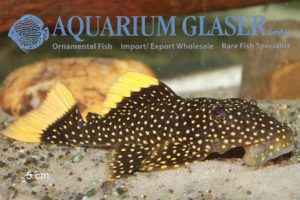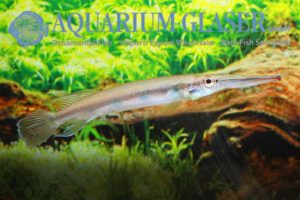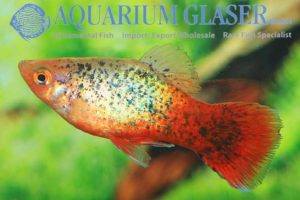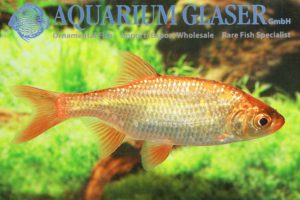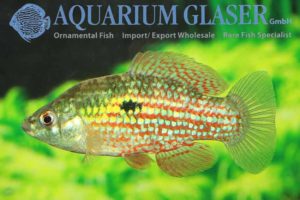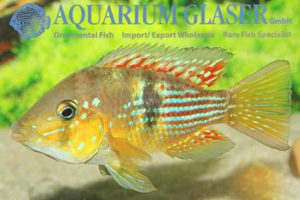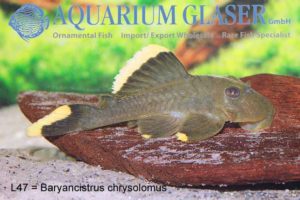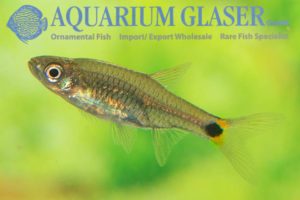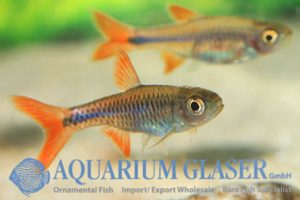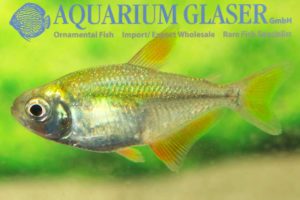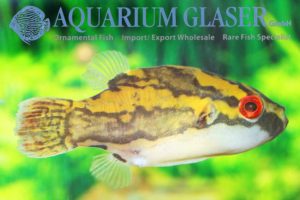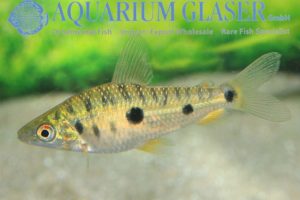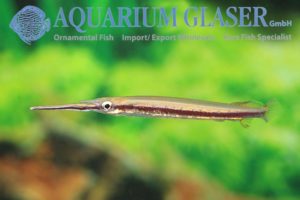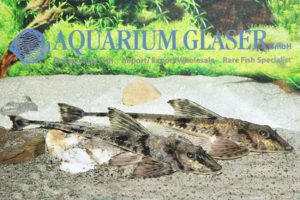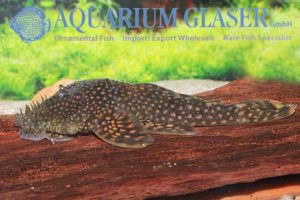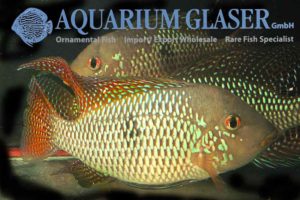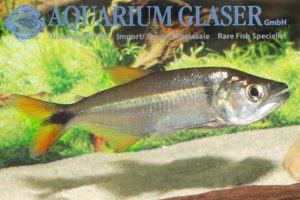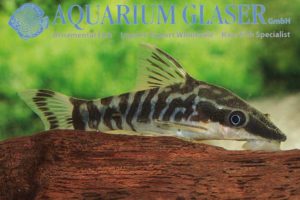Divine discus of this variety which have a very high degree of red coloration reached us recently. For our customers: the fish have code 739036 on our stocklist. Please note that we exclusively supply the wholesale trade. Text & photos: Frank Schäfer
Fish Archive (2977)
-
-
Neetroplus panamensis, variety RED
We have received wonderful German bred specimens of this relative small, very colorful and extreme rarely offered cichlid. Males become around 13 cm long, females stay smaller. According to the latest systematic revision the fish is placed now in the genus Cryptoheros, subgenus Panamius. For our customers: the fish have code 684602 on our stocklist. […]
-
Mylossoma duriventre
We received a limited number of wonderful specimens of the real Mylossoma duriventre (size: 7 – 10 cm) from Paraguay. For our customers: the fish have code 271204 on our stocklist. Please note that we exclusively supply the wholesale trade. Text & photo: Frank Schäfer
-
Brittanichthys axelrodi
++ Currently (january 2011) a good number of wild collected animals of that species reached us! Code 211902 ++ Every now and then you will find this very sensitive tetra (which is above all prone to stress) among a few specimens of Cardinals Paracheirodon axelrodi. If used to aquarium conditions, however, it is very enduring […]
-
Brittanichthys axelrodi
This wonderful and exotic tetra is only very rarely available. Now we can offer them in top quality and adult, although only in limited numbers. The males can be recognized by the strange glandular scale in the caudal fin. The use of that scale is unknown. Size of the fish: 3-4 cm. For our customers: […]
-
Roeboides araguaito
For the first time ever we have this nice predatory tetra from Venezuela in stock. The largest specimen known so far was 11 cm long (without caudal fin), we have received a limited number of specimens in the sizes 6-8 cm (code 289174 on our stocklist) and 8-10 cm (code 289175 on our stocklist). Please […]
-
Pelvicachromis signatus
We recently received this beautiful dwarf cichlid from Guinea. The species is a close relative of P. humilis and was known in the hobby as P. sp. “Bandi 1” before its scientific description. Maximum size in males is around 10 cm, females stay always smaller. As in almost all Pelvicachromis there is an extreme sexual […]
-
Farlowella platorhynchus
The needle suckers (Farlowella) belong to the most specialized Loricariids at all. Their whole life is dedicated to the trick to look like a stick. Currently we received fantastic, up to 18 cm long Farlowella platorhynchus from Peru. There is a lot of variation observable regarding coloration. Males and females can be distinguished best by […]
-
Distichodus affinis
Currently we can offer the very rare Distichodus affinis from the Congo in limited numbers. The males have beautiful red fins and stay much smaller than the females (males 5 – 6 cm, females 8 – 10 cm). For our customers: the fish have code 123002 on our stocklist. Please note that we exclusively supply […]
-
Chela dadiburjori
This nano gem reached us from the south of India; the charming dwarf fish reaches a maximum size of 3 cm. For our customers: the tiny animal has code 409502 on our stocklist. Please note that we exclusively supply the wholesale trade. Text & photos: Frank Schäfer
-
Cyclopsetta sp.
The flatfishes (Pleuronectiformes) are a quite successfull order of fishes, comprising 11 families, 108 genera and about 572 species. Most of them are marine, only 4 species are known to live completely in fresh water, but many species are found in the brackish water of the lower reaches of rivers at least during their youth. […]
-
Corydoras virginiae
Currently we have one of the most attractive species of Corydoras from Peru in stock. This species caused – along with some other species – the Corydoras boom that started more than 15 years ago. At this time C. viriginiae was still undescribed was called “C4”. This Corydoras is a schooling fish. Moreover it is […]
-
Copella arnoldi
Just in: extraordinary beautiful splashing tetras in XXL-size, German bred. For our customers: the animals have code 219554 on our stocklist. Please note that we exclusively supply the wholesale trade. Text & photo: Frank Schäfer
-
Corydoras sp. Neon Red Stripe
Currently we have a top rarity in stock: the extremely rarely imported Corydoras sp. Neon Red Stripe! Until now we could offer only bred ones from time to time. These beautiful, wild collected fish are available only in very limited numbers! For our customers: the fish have code 221033 on our stocklist. Please note that […]
-
Barbus conchonius
You think you know quite well the rosy barb? Please take a look on our photos of the fantastic wild collected ones we currently have in stock and think about it. In fact wild collected rosy barbs – our specimens originate from the vicinty of Calcutta, the type locality of Barbus conchonius – look completely […]
-
Crenicichla cf. lugubris RED ATABAPO
At least we managed to import a small number of one of the most beautiful pike cichlids at all. Breeding fish become deep red all over the body, and even outside the breeding season the fish are spectacular. For our customers: the animals have code 670715 on our stocklist. Please note that we exclusively supply […]
-
Hampala macrolepidota
There are only very few predatory species among the barbs. Like all Cyprinidae, they do not have teeth in their jaws, but only in the throat. So it is not that easy for a barb to fix a food fish. Among the rare exceptions are the barbs of the genus Hampala. There are 6-7 accepted […]
-
Guppy NEW Arctic Blue
For the first time ever we have this beautiful new Guppy in stock. For our customers: the fish have code 418763 on our stocklist. Please note that we exclusively supply the wholesale trade. Text & photos: Frank Schäfer
-
Ageneiosus sp. III GREEN STRIPE
We received a very limited number of this dolphin cat from Peru. The species may reach about 20 cm in total length, currently the fish are 7-10 cm long. For our customers: the animals have code 203264 on our stocklist. Please note that we exclusively supply the wholesale trade. Text & photos: Frank Schäfer
-
Moenkhausia sanctaefilomenae WILD
There are species of fish that are so commonly seen in the trade that we sometimes forget to look at them with the eyes of a child. One of these species is the red eye tetra, one of the top classics among the ornamental fish species They can be found in any pet shop around […]
-
Tatia sp. Tahuayo River
We received this pretty new species currently from Peru in small numbers. The Tahuayo river, a tributary of the Amazon river, was given as collecting site. Our specimens are 10-12 cm long. They cannot be assigned for sure to any known species. Obviously it is a close relative of Tatia nigra from the central Amazon […]
-
Tridensimilis brevis
Currently we received the cute freeswimming dwarf glass cat Tridensimilis brevis from Peru. The fish attains a maximum length of 3 cm. It belongs to the notorious candiru relationship, but is no blood sucker at all. This tiny catfish is that translucent that it is possible to observe the way of the food from the […]
-
Leptodoras juruensis
Once more we were able to import the very rare, bizarre Leptodoras juruensis from Peru in a very limited quantity. For our customers: the fish has code 266065 on our stocklist. Please note that we exclusively supply the wholesale trade.
-
Cichla kelberi
For the first time ever we have Cichla kelberi in stock, a species that was only recognized in 2006. The fish is available only in a very limited number. The species is distinguished from its closest relative, C. monoculus, by the presence of light spots in the pelvic fins, the anal fin and the lower […]
-
Erythrinus sp. TAHUAYO RIVER
Another recent first importation from Peru: a new species of Erythrinus! It is clearly distinguished from the other two species of Erythrinus known so far from Peru, eg Erythrinus erythrinus (see http://www.aquariumglaser.de/en/erythrinus-erythrinus-_de_1009.html) and E. sp. Madre de Dios (see http://www.aquariumglaser.de/en/erythrinus-sp-madre-de-dios_de_1324.html) by the fine, whiteish-blue seam on the caudal fin. Our specimens are still too small […]
-
Ageneiosus cf. atronasus
For the first time ever we received now this interesting doplhin catfish from Peru. In contrast to many of its congeneers this species stays relatively small and reaches only 12 cm in total length. Thus it is suitable also for normal sized home aquaria. However, one should always keep in mind that these catfishes are […]
-
Crenicichla lugubris ORINOCO
We received beautiful Crenicichla lugubris from Venezuela in three sizes. It is astonishing how drastically these fishes change their coloration during their onotgenesis. Juveniles that show the typical “French fries pattern” are schooling fish that feel very unsafe when kept alone. Then the fish come in the age of puberty. Now they see congeneers only […]
-
Parosphromenus cf bintan SINTANG
The charming licorice gouramis are ideal inhabitants of nano tanks. They can not compare with other fish and so they settle even in nature extreme habitats. The water there is very poor in nutrients, very soft and acidic. These dwarfs among the anabantoids become astoundingly old and can easily reach an age of 5 or […]
-
Dawkinsia (formerly Barbus) rohani
It was only last year that this beautiful Indian barb has been described scientifically. It originates from the south of India. Presently it is only known from hill streams in the Kanyakumari District, Tamil Nadu. It differs from the other Indian barbs of its closer relationship (eg D. arulius, D. assimilis, D. exclamatio, D. filamentosa, […]
-
Sphaerichthys acrostoma
Currently we have the rarest species of chocolate gourami in stock, the Golden Choco-Gourami. This is the largest of all species of Sphaerichthys, maximum length is around 6 cm. Keeping and breeding this species – it originates from Borneo – is comparable to that of S. vaillanti (http://www.aquariumglaser.de/en/sphaerichthys-vaillanti-_de_756.html) Text & Photos: Frank Schäfer
-
Ancistomus sp. L387 “Orange” – young adults in stock
The wonderful L387 is only very occasionally available. Currently we have young adults of 5-7 cm length in stock (females are smaller than the males). Our animals are German bred ones. For more information, please check http://www.aquariumglaser.de/en/ancistomus-sp-l387—beautiful-bred-ones-available_en_1284.html Text & photos: Frank Schäfer
-
Tetragonopterus argenteus
Code 266004
-
Osteoglossum bicirrhosum
Code 273208
-
Macropodus ocellatus
Code 425403
-
Fundulopanchax cinnamomeus
Fundulopanchax cinnamomeus We are glad that we are able to offer more and more species of the colourful group of killifish from German breeders. New in stock: Fundulopanchax cinnamomemus. This is a very nice species that reaches about 6 cm in total length. The fish belongs to the large group of Aphyosemion relatives. The species […]
-
Hisonotus nigricauda
For the first time ever we were able to import this charming dwarf catfish from Paraguay. The species looks quite similar to the well known “Otocinclus Negros” (the correct specific name of that fish is Otothyopsis piribebuy) and can be kept the same way. The most obvious difference between the two species is the coloration […]
-
Mystus bocourti
Due to its extremely prolonged dorsal fin this fascinating species has also been placed in a genus on its own for a long time, namely Heterobagrus. The catfish becomes around 20-25 cm long. It is a very peaceful species; however, fish of small size will be taken as food, but neither congeneers nor any other […]
-
Hypancistrus sp. L400
Code 26480-L400x-2
-
Crenicichla sp. Atabapo
Code 672534
-
Crenicichla lenticulata
Code 670005
-
Crenicichla johanna Puerto Inirida
-
Tanganicodus irsacae “Ikola”
Code 576002
-
Eretmodus cyanostictus “Kavala”
Code 520502
-
Boraras naevus
The dwarf rasbora that is traded under the name of “Boraras micros RED” for some years already, has been described now scientifically and has been named Boraras naevus. The species is distinguished from all other spotted Boraras species known so far by the sexual dichromatism. The B. naevus males develope a much bigger shoulder spot […]
-
Leporinus brunneus
For the first time ever we were able to import this beautiful, large tetra from Venezuela. The fish can reach a maximum size of 25-30 cm. It can be found in the basins of Orinoco river and the rio Negro. The coloration of the fish is quite variable, depending on the origin. The orange spot […]
-
Trachelyichthys sp. Tapajos
We currently received this cute driftwood catfish from Brazil. Initially we thought all fish of the import would belong to the same, highly variable coloured species; but in the meantime we found that in fact two species were involved, namely T. sp. “Tapajos” and Auchenipterichthys punctatus. Most probably Trachelyichthys sp. “Tapajos” becomes as big as […]
-
Acestrorhynchus cf. minimus
The barracuda tetras (Acestrorhynchus) from South Americ are beautiful predators, which are much sought for among specialized aquarists with large tanks. Several of the approximately 14 species accepted currently become 20 to 40 cm long, but there do exist also small species in the genus that become never larger than 10 cm. We received from […]
-
Apistogramma cf. juruensis Black Chin
We just received this beautiful dwarf cichlid from Peru. The determination of the several phenotypes of Apistogramma is not easy at all. Currently most persons that work with Apistogramma tend to the point of view that the fish that looks almost identical, but has blue lips represents the “real” A. juruensis, while the fish with […]
-
Teleogramma brichardi
Currently we have a limited number of the very rare cichlid Teleogramma brichardi from the Congo in stock. For our customers: the fish have code 576303 on our stocklist. Please note that we exclusively supply the wholesale trade.
-
Teleogramma brichardi
Currently we have a limited number of the very rare cichlid Teleogramma brichardi from the Congo in stock. For our customers: the fish have code 576303 on our stocklist. Please note that we exclusively supply the wholesale trade.
-
Apistogramma agassizii Flamenco
Currently we received one of the most beatiful varieties of Apistogramma agassizii in limited numbers. The variety “Flamenco” is collected in the wild, but according to our exporter it does not represent a local population. The Flamenco variety is selected from other “normal” Apistogramma agassizii catches. It is well known that under aquarium conditions it […]
-
Skiffia multipunctata
One of our proofed breeders supplied us with a very nice collection of some Goodeids, which are very seldom available in the trade. However, we have only limited numbers in stock. One of the pretties species is Skiffia multipunctata. The males vary a lot regarding coloration, so a tank with Skiffia multipunctata is very intersting […]
-
Synodontis multipunctatus
Code: 183003
-
Holpias curupira
Code: 258606
-
Satanoperca mapiritensis
We obtained this wonderful, glittering eartheater from Venezuela. The size is 15-18 cm. Members of the genus Satanoperca are also called “devilfishes”, but despite this horrible name the fish are extremely peaceful. They live over sandy bottoms which they browse through in search for food. In such a habitat it makes no sense to defend […]
-
Synodontis sp. aff. nigriventris ZEBRA
We currently have a limited number of the very pretty and rare Synodontis sp. aff. nigriventris ZEBRA in stock. The species differs from the “common” Upside Down Catfish by the extremely contrasting pattern. The species is – as far as it is known – restricted to the Mai Ndome region in the DR Congo. Size […]
-
Xenopus laevis
By chance we had the opportunity to get wonderful, large (6-8 cm) Xenopus laevis from a German breeder. Available only in limited numbers! For our customers: the animals have code 192505 on our stocklist. Please note that we exclusively supply the wholesale trade.
-
Parakysis verrucosus
For the first time ever we received this tiny and charming dwarf fish from Malaysia. It reaches only 3-4 cm in length. The species is adopted to black water habitats in nature, where the water is very soft and acidic. However, in our facility they have proofed so far to be unproblematic and quite gregarious. […]
-
Caridina “Black Tiger Yellow Eyes”
The black tiger shrimp is a cultivated variety of the tiger shrimp that originates from southern China. The tiger shrimp itself is a very variable species and possibly belongs to the species described as Caridina cantonensis. The bright shining eyes and the fantail in the same colour are very characteristic for the animal. We have […]
-
Plectrochilus erythrurus
We managed to import a few specimens of the exteme rarely imported, blood sucking Candiru-catfish species Plectrochilus erythrurus, which have currently a length of 12-15 cm, from Peru. For our customers: the fish have code 280754 on our stocklist. Please note that we exclusively supply the wholesale trade. Text & photos: Frank Schäfer
-
Neocaridina heteropoda RILI
The Cherry red shrimp belongs to the most popular dwarf shrimps in the hobby. Keeping and breeding is very easy and can be done even by beginners. The tiny animals produce such a lot of offspring that the species is sometimes even used as a feeder animal. Neocaridina heteropoda originates from East Asia (China, Japan, […]
-
Cynopotamus atratoensis
It is a very rare occasion that predatory tetras of the genus Cynopotamus are imported, due to their sensibilty against stress and transportation. So we are extremely happy and prous that we have been able to manage an importation of not less than eight specimens from Venezuela. The fish have a size of 18-22 cm […]
-
Channa sp. Laos Fireback
For the first time ever we received this splendid snakehead, which obviously represents a species unknown to science so far. I reminds one strongly to the far spread and variety rich species C. gachua, but the “Fireback” is much bigger, reaching 15 -20 cm, it lacks the stripes in the pectoral fins, which are so […]
-
Tropheus sp. Yellow
Currently we have extreme beautiful Tropheus sp. “Yellow” in stock which already display bright colours when young! For our customers: the fish have code 586302 on our stocklist. Please note that w exclusively supply the wholesale trade.
-
Myleus rubripinnis
We received magnificent M. rubripinnis from Venezuela, which we call “sp. rubripinnis RED” due to their intensive red colours. Code: 270392. Our specimens are 4-7 cm long. Please note that we exclusively supply the wholesale trade. Text & photos: Frank Schäfer
-
Channa aurantimaculata
Just in: one of the most beautiful of all species of snakehead, available only in limited numbers. Size up to 40 cm, our fish currently are 20-25 cm long. For our customers: the fish have code 409014 on our stocklist. Please note that w exclusively supply the wholesale trade.
-
Lepidarchus adonis
Currently we have this beautiful and extreme rare dwarf tetra (maximum length: 3 cm) in good numbers in stock. Code: 145303. Please note that we exclusively supply the wholesale trade.
-
Corydoras sp. C141
One could term this beautiful cory also the long-nose schwartzi. Obviously the species has not been described scientifically yet. It is not known from which river the fish originates. Sometime C141 is confused with C. ornatus, but the latter has never a cream-white dorsal spine. C141 attains a length of about 6 cm. Code: 241724 […]
-
Corydoras schwartzi
This good old fashioned, but still very beautiful cory originates from the system of the Rio Purus in Brazil. In contrast to the other species mentioned here the dorsal spine is only occasionally cream-white. The species belongs to the group of stout Corydoras with round noses. It can be quite easily recognized by the black […]
-
L261a – Ancistrinae gen. sp.
This species of fish is among the rarest of all L-numbers. It belongs not only to none of the species described so far, but also cannot be applied to any described genus. L261 was imported initially from the Orinoco in Venezuela. The individual we were able to import now for sure belongs to the same […]
-
Eigenmannia trilineata
We received wonderful specimens of Eigenmannia from Guyana. They show three black longitudinal stripes on a smokey ground. This fits perfectly to the pattern described in the species E. trilineata, which is known so far only from the Paraguay-Paraná system (Argentina, Brazil, Paraguay, Uruguay). May that be as it is: Eigenmannia are fantastic aquarium fish […]
-
Rachoviscus crassiceps
Finally we are able to offer once more this beautiful, but sadly only very occasionally available tetra. However, even now we have only a limited number of them. Although the fish is really beautiful – one of the most attractive features is the deep red adipose fin – this is not the main excitement for […]
-
Corydoras guapore
Sadly this charming cory is only occassionally available. We recieved once more a small number of the fish. For our customers: the species has code 230504 on our stocklist. Please note that we exclusively supply the wholesale trade. Photo: Frank Schäfer
-
Adontosternarchus clarkae
This small (maximum length up to 20 cm) knifefish from Venezuela is only rarely imported and again we were able to obtain only a few specimens. It is a very nice and peaceful species. The genus Adontosternarchus currently comprises four accepted species which can be distinguished best by differences in the head profile in combination […]
-
Panaque sp. L418 Shampupa
The magnificent Panaque species which belong to the P.-nigrolineatus-complex are much sought for ornamental fishes. All species seem to become around 40 cm long. One of the most spectacular ones originates from Peru and received the L-number 418. Characteristic features of the fish, which is called Shampupa by the exporters, is the broad light band […]
-
Characidae gen. sp. “Yellow Glass Tetra”
For the first time ever we were able to import this charming dwarf tetra from Peru, which cannot be placed in any known genus or species so far. Our largest specimens are about 1.5 cm long. Of course it is possible that our fish represent only juveniles of a larger species, but this thesis seems […]
-
Apistogramma iniridae
Sadly this beautiful dwarf cichlid is only occasionally available, but currently we were able to import once more beautiful, fully grown specimens. The fish are very stable and display all the behaviour that makes the keeping of these fish so desirable. Like its close relative A. uaupesi, which differs from A. iniridae mainly due to […]
-
Lamprologus werneri
Most hobbyists think about the cichlids of Lake Tanganyika when they hear the generic name Lamprologus. But there do exist also some species of river-dwelling (= riverine) Lamprologus. The most attractive species among them is without any doubt Lamprologus werneri, which we were able to import now once more. The slender fish is spread all […]
-
Dianema sp.
The genus Dianema comprises currently only two valid species (D. longibarbis and D. urostriata), which are pretty easy to distinguish due to the very different coloration of the caudal fin. From Brazil we now received a third species under the name of “RED ITUXI”. Obviously the collectors in the field observed that the basic colour […]
-
Caecomastacembelus brichardi
One expects blind species of fish from cave systems or the deep sea. But in the rapids of the lower Congo river not less than 5 different species of blind fish exist (among them the only blind species of cichlid of the World, Lamprologus lethops) – and nobody can explain why these fish are blind. […]
-
Pterobunocephalus depressus
This is by far the most attractive species of all banjo cats – and the rarest. We recently received the fish for the first time from Peru. It is also one of the most variably coloured species of banjo cat. Most specimens have a sharp black-and-white contrasting pattern, being white anterior and black posterior. But […]
-
Astroblepus from Peru imported!
The L-numbers or Loricariidae belong to the most popular species of catfish from South America. But even very experienced aquarists will hardly ever had the opportunity to see alive a specimen of the genus Astroblepus, although the family Astroblepidae, which includes the single genus Astroblepus, is the closest relative of the loricariids. Astroblepids are distinguished […]
-
Baryancistrus sp. L81n
We take the opportunity of the receipt of a larger shipment of L81n and the scientific description of Baryancistrus xanthellus (L18, L81, L85, L177, see http://www.aquariumglaser.de/en/news/l18_l81_l85_l177_and_l47_described_scientifically_en/) to take a closer look on L81n, which we get from Sao Felix do Xingu, once more. As in all ancistine catfish it is also true in L81n: the […]
-
Hemirhamphodon kuekenthali
Gorgeous, large specimens of this livebearing halfbeak reached us from Borneo (Sarawak) recently. The species can hardly be told apart from the better known relative, H. pogonognathus. However, we have the feeling that it is a bit stouter. But our determination bases mainly on the origin (Sarawak). Like all other Hemirhamphodon, H. kuekenthali is a […]
-
Platy Leopard
Platys with black dots are known quite long already. Initially they were termed Salt´n´Pepper-Platys, later Moskow Platys. Our reliable breeder has now developed two extreme nice strains of black dotted platys, which we call “Leopard Platys”. The first variety has a blue-green body and an intensive red tail (including the tail fin). This variety we […]
-
Scardinius erythrophthalmus GOLD
Scardinius erythrophthalmus GOLD The rudd (Scardinius erythrophthalmus) is the only species of freswater fish native in Central Europe that is specialized in feeding on soft water plants and algae. Thus it is a perfect helper for garden ponds where algae and especially duckweed should be reduced. As the rudd likes to swim in the upper […]
-
Jordanella floridae
It does not necessarily have to be a new species of fish to make us enthusiastic. This good old fashioned killifish is in fact part of our standard stock. Most often the fish are bred ones from Indonesia. But recently we were able to import very large specimens from Florida, the native home country of […]
-
Gymnogeophagus meridionalis
Currently we have magnificent (German pond bred!) specimes of that cichlid, which is almost a dwarf cichlid (our fish are between 5-7 cm long and fully mature and in colour) in stock. There is still no agreement among the specialized aquarists, if this form represents a population of Gymnogeophagus meridionalis, G. rhabdotus or if the […]
-
L18, L81, L85, L177, and L47 described scientifically
These plecos, which originate from the Rio Xingu and its tributary Rio Iriri belong to the most popular L-numbers. Now they have been described scientifically. L18, L81, L85, and L177 belong to the same species (although L81 has not been mentioned in the paper) and have been named Baryancistrus xanthellus, whereas L47 has been named […]
-
Rasbora brittani
At the first glimpse this pretty Rasbora may look a bit colorless; however, if the fish is kept in the perfect milieu (blackwater conditions and dimmed light) it looks really beautiful. Due to a number of anatomical specializations, the species has been recently placed in a new genus, namely Kottelatia; so the most actual scientific […]
-
Rasbora lacrimula
Rasbora lacrimula For the first time ever we can offer this beautiful Rasbora, which has been described scientifically only in 2009. R. lacrimula is endemic in the Mahakam basin, Kalimantan Timur Province on Borneo. Regarding coloration this new Rasbora reminds one in R. reticulata and R. vulcanus, but R. lacrimula stays much smaller. Maximum length […]
-
Gymnocorymbus socolofi
The genus Gymnocorymbus comprises only three species, one of which – the Black Skirt tetra, G. ternetzi – is among the most popular ornamental fish. The other two species are absolute rarities. So we are glad to be able to offer one of them, the rare Gymnocorymbus socolofi from Colombia, once more. This tetra reaches […]
-
Carinotetraodon borneensis
At least we successfully imported one of the most mysterious species of freshwater pufferfish: Carinotetraodon borneensis. Although the species as been described already in 1903, it was considered over decades as a junior synonym of a closely related species, C. lorteti. However, both species look extremely similar in alcohol. In live the fish look quite […]
-
Leporinus steyermarki
Leporinus steyermarki is a beautiful large tetra. It can reach a maximum size of about 30 cm and originates from Venezuela. In German, the fish is now and then named “Grey Leporinus” which is for sure not describing accurately the coloration of the animal. Maybe this name bases on a confusion with another of the […]
-
Hemirhamphodon tengah
This pretty little fish is a challenge for experienced hobbyists. The species originates from Borneo. In contrast to the widespread prejudice halfbeaks of the genus Hemirhamphodon do not appear in brackish water; they are strictly bound to very soft and acidic water! These fishes are commonly found along with chocolate gouramis and small rasboras. The […]
-
Loricaria simillima from Paraguay arrived
Beautiful wild collected specimens of this mouthbrooding whiptail cat arrived right now from Paraguay. Read more about this fish here: http://www.aquariumglaser.de/en/fish-archive/catfish-en/loricariidae-en/Loricaria_simillima_en/
-
Ancistrus sp. L309
Finally we were able once more to import this very nice and unique member of the specious genus Ancistrus: L309. The species has not been described scientifically yet and originates from the Rio Tapajós. The fish is so different from the other members of the genus that is was even thought at times that it […]
-
Geophagus iporangensis
There are more exotic fishes that can be kept and bred at least seasonally in garden ponds than most aquarists think of. Among these species are for sure the different types of Brazilian Pearl Cichlids, the Geophagus-brasiliensis-complex. The group is only poorly understood scientifically, but who cares for names if one looks at these glorious […]
-
Oligosarcus jenynsii
This pretty predatory tetra is only imported very occasionally to Europe, although the up to 30 cm long species is quite common in the southern parts of South America (Argentina, Brazil, Paraguay, Uruguay). The photographed specimen originates from Paraguay. Basically speaking, Oligosarcus is nothing else but a Banded Astyanax (Astyanax fasciatus) that has been developed […]
-
Otocinclus cocama
The dwarfish catfishes of the genus Otocinclus are usually kept due to their algae-eating activities and their nice behaviour. The coloration of most of the species is only rather dull. Otocinclus are very famous for cleaning especially the waterplants without hurting them. Could it be that there exists a species that is not only very […]
- « Previous Page
- 1
- …
- 21
- 22
- 23
- 24
- 25
- …
- 30
- Next Page »





